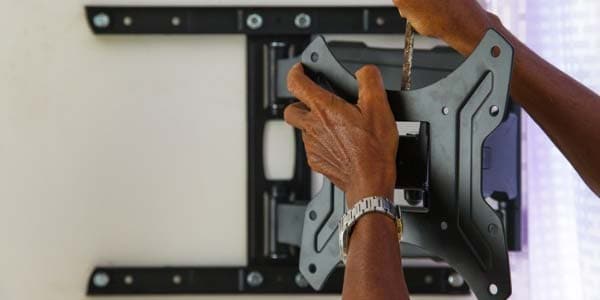Buying a TV has become a complicated process. Perhaps back in the day, it was as simple as running to the store, getting one, plugging it to your antenna and voila! You’ve got yourself a running Television. However, times have changed since then. Today, when you run to the store to get yourself a TV, there are dozens of factors that you have to take into consideration:
Flatscreen or Curved display? What’s the right size and dimensions that would fit your needs? Should it be a Smart TV? What are the additional features that you need? 4K Ultra HD? Surround Sound Speakers? Sound Bars? How many HDMI ports do you really need?
When purchasing a flatscreen TV, another essential that you need to buy is the wall mount. A TV wall mount is not an optional accessory that you can opt not to get. Due to thinner screens, the majority of flatscreen TVs cannot stand on their own. At the same time, wall mounts give homeowners more space as they do not require a TV table, unlike old TVs.
This will, however, entail another bout of discussions for wall mounts like what’s the best tv wall mount for plaster walls? Can your walls sustain the weight of a TV? Where will you place your wall mount? And what’s your budget for this? Choosing the best TV wall mount is crucial to optimizing your watching experience.
Here I have listed down some of the common types of TV wall mounts and its pros and cons.
Fixed TV Wall Mount
A Fixed TV Wall Mount is the simplest option. This type of wall mount is the cheapest among its peers and also has the shortest installation time of all. It is comparably quick to install as these low-priced wall brackets just need to be drilled into a section of your house.
However, there is a catch. Once attached, you cannot adjust or move the bracket at all. Fixed TV wall mounts do not allow any adjusting which may hamper your watching experience. If you choose to go with this type, make sure that you carefully and extensively measure the position of your TV. The height and angle of the screen will play a huge factor as to whether you will enjoy your nightly ritual of watching football or not. Another disadvantage of a fixed TV wall mount is that adding or removing an HDMI cable will require you to remove the TV from the wall bracket.
Tilting TV Wall Mount
For an additional amount, you can get a tilting TV wall mount instead. Tilting wall brackets are a sure upgrade from a fixed TV wall mount. A tilting bracket allows its users to adjust the screen angle from 5 to 15 degrees vertically. This makes for a much better watching experience. Not everyone has the same height when seated so finding the optimal angle every time you sit down to watch is necessary.
There is one catch to a tilting bracket though. It does not have the capability to move horizontally.
Full Motion TV Wall Mount
A full-motion TV wall mount offers full flexibility for your TV angle. Because of its range, it has also been called as an Extending Arm and Swivel. You can have it anchored in one side of the wall and have its swivelling arm extend outwards, offering you a better angle wherever you are positioned.
With the full-motion TV wall mount, you can adjust your TV depending on your watching position. You can take a seat, slouch, or even lie down and it wouldn’t be a problem. This wall mount is the one that adjusts instead of you giving up comfort for a better watching angle.
Of course, there is still a catch to this option. A full-motion TV wall mount is considerably pricier than the regular wall mounts and bracket. It is a small price to pay though for total control of your viewing experience. Arranging your cables will also be a much easier process.
TV Stand
If your walls are flimsy and are not made of sturdy material, then there is, of course, the option of mounting your TV on a tabletop, counter, a shelf, etc. By using a TV stand, you do not have to do any drilling or installing. If you live in a rented space where you can’t drill or stick stuff into your walls, a TV stand is a perfect solution.
Unfortunately, a TV stand has a lot of disadvantages. It takes up a lot of space, especially if you have to bring in an extra table for your TV. At the same time, if you have kids, a TV that’s not fixed to the wall can prove to be quite problematic. People can bump into your table or counter and knock the TV over.


